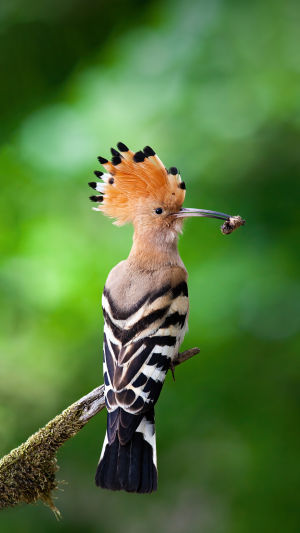Many people mistake the common hoopoe for a woodpecker, but it is not.
The woodpecker does not have this colour scheme, nor does it have such a long, thin beak.
The common hoopoe is the best bird to identify, even if it is far away from you.
If you see a yellow neck, black and white flowered wings, a long beak, and a handful of hair, you can boldly identify it as a common hoopoe.
The common hoopoe inhabits open places such as mountains, plains, forests, forest edges, roadsides, river valleys, farmlands, grasslands, villages, towns, and orchards, and is especially common in cultivated habitats along forest edges.
In winter, it is mainly found in low-altitude places such as plains at the foot of mountains, and in summer, it can go up to high-altitude areas of 3000 meters.
Commonly scattered alone or in pairs in the mountains or plains of open land, cultivated land, orchards, and other ground foraging, when frightened, or fly to the nearby small trees, or fly to a small slope not far from a rock.
Mostly alone or in pairs. They often walk slowly on the ground, foraging while walking, and when frightened.
They fly up to the branches of trees or fly for a distance and then land, and their wings flap slowly when flying.
When the common hoopoe is resting or foraging on the ground, the crown of its plumage is open, shaped like a fan, and when it is frightening, it immediately closes on its head.
It has a tamer temperament and is not too afraid of people. When calling, the crown feathers rise, and with the call, the crown undulates, and when calling.
The throat and neck are elongated and bulge, the head is stretched forward, and the head nods continuously while walking.
It mainly feeds on insects and larvae of Leuctridae, Orthoptera, Hymenoptera, Coleoptera, and Lepidoptera, such as locusts, mayflies, stoneflies, golden turtles, worms, jumping locusts, moths and butterfly larvae and adults, and also eats worms and other small invertebrates.
Foraging is mostly on the grass at the forest edge or in cultivated land, often inserting their long beaks into the soil to feed.
During the breeding season, males often fight to protect their territories.
When fighting, both sides approach each other, first with their crowns high and their beaks stretched downward as far as possible, then suddenly biting the tips of each other's beaks and pulling them into a straight line like a tug-of-war to maintain a certain safe distance.
The breeding period is from April to June. Pairs breed in nests.
Sometimes there is also competition between males for females.
Usually nest in natural cavities at forest edges or along forest roads, or in abandoned holes by woodpeckers.
The size and diameter of the cavity vary greatly depending on the environment, and in areas of farmland at the foot of the mountains where cavities are lacking.
They also nest in holes in the walls of abandoned houses and between crevices in cliff walls, and even under piles of dry branches on the ground.





